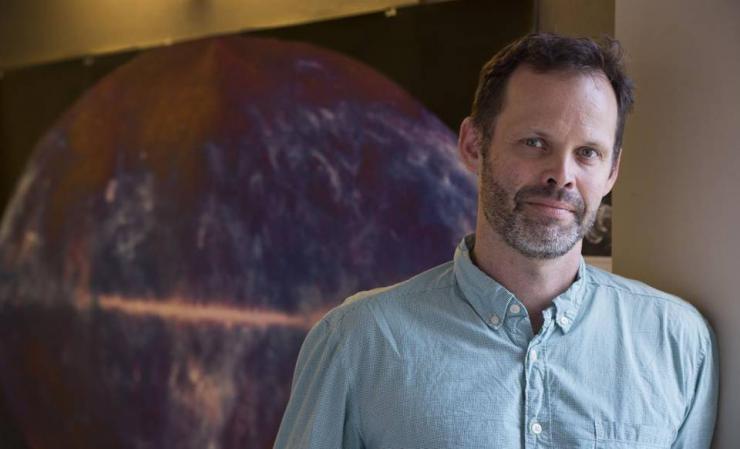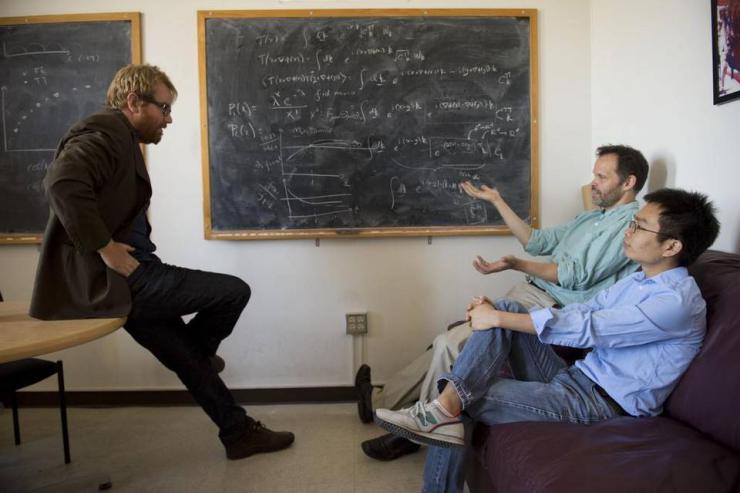Understanding the Big Bang? It happens on a dusty blackboard at UC Davis
Lloyd Knox hunts for answers about the universe's creation
The cosmologist has boosted the search for particles called neutrinos that are key to research
His research measures the universe's origins 13.8 billion years ago

Lead researcher and team leader Lloyd Knox is working on research into neutrinos and other items that physicists use to unvavel the secrets of the Big Bang. Lezlie Sterling lsterling@sacbee.com

The letters, numbers and symbols written across a blackboard in Lloyd Knox's office are like words in an epic novel. It's a story that begins 13.8 billion years ago, and the first chapter is the Big Bang.
The 47-year-old Knox, who teaches physics and cosmology at UC Davis, is one of that story's main authors, along with the graduate students he involves in his mind-bending work.
His aim is to understand how the universe was formed, and doing that requires surveying the vast expanse of the ancient cosmos and hunting for an elusive and ghost-like particle called the neutrino.
That work takes place in a fifth-floor office of the campus' aging, nondescript physics building where, by a blackboard, he huddles with graduate students Zhen Pan, Marius Millea and Brent Follin. Much of the data they use comes from remote radio telescopes, one at the South Pole, another as part of the space-based Planck telescope.
What he does with that data is not particularly high-tech. In his office, Knox has perched his computer screen on a cardboard wine box. Chalk is a major tool. Knox suggests a research focus, which triggers his team to compare data and statistical information with its calculations. Findings are discussed. Sometimes some new observation, however tiny, is found in the math.
That happened last month when Knox and his team found evidence of neutrinos spreading through the glowing soup of particles left over from the Big Bang, known as the cosmic wave background. The finding confirms mathematical predictions that neutrinos existed in the first seconds of the universe, and brings cosmologists one step closer to learning how the universe began, evolved and may still evolve.
"Knox understands the theory, knows the nuts and bolts of the experiments, and is one of the world's experts at complex data analysis,†said Edward "Rocky†Kolb, physics professor at the University of Chicago and co-author of "The Early Universe,†the standard textbook on particle physics and cosmology. "It's uncommon that someone is truly expert in any of those three areas, and exceedingly rare that a scientist excels in all three.â€
Knox uses mathematics to understand phenomena at a terrifyingly massive scale. One measurement scrawled above his blackboard on a piece of paper reads: 1 centimeter = 1 billion light years.
"When I tell people what I do, they want to know how I can even fathom the kinds of distances and time scales I work with - and that kind of makes me realize that I don't,†said Knox. "Mathematics is what helps you get to a place that you cannot even imagine in your mind.â€
In the classroom, Knox is decidedly down to earth, and game to try new approaches for teaching incredibly complex science.
He has brought his guitar into introductory classes and is keen on taking pop songs and layering lyrics about physics over them, with melody intact. He did so last winter when he adapted "In the Aeroplane Over the Sea†by the indie rock band Neutral Milk Hotel. Now titled "Dark Energy,†the song begins with the lyric: "Sometimes the death of a star...â€
"In my opinion, playing that song for us really helped to support and extend the encouraging atmosphere that Knox had already established in the classroom,†said astrophysics junior Emily Scheide. "He was willing to put himself on the spot in playing that song, so why couldn't we put ourselves on the spot and ask more questions?â€
Knox's next musical endeavor: adding physics lyrics to the '70s-era rock classic "American Pie†by Don McLean.
"Physics and science, in general, is not about remembering more equations than your peers, but about a beautiful and elegant interpretation of existence,†said Evan More, a UC Davis senior and also a former student. "Why should such a fascinating subject be encumbered by droning lectures and a pre-approved curriculum?â€
Knox's immersion in science began as soon as he started reading. A fascination with the cosmos was paramount. In high school, he became intrigued with books on quantum mechanics, which he said "radically reorients one's view of reality. It posits very strange things.â€
Cosmology would not become his calling until graduate school. Knox said it seemed like a foregone conclusion that he would end up at the California Institute of Technology, but then he visited the University of Chicago, where he said he "heard all the open questions that were being asked in cosmology.â€
At Chicago, he combined his childhood love of astronomy with a quest for defining certain laws of nature, and it proved a good fit. He earned his doctorate in 1995, and was a model student. "Some students need a gentle guiding hand, others need a firmer hand. But Lloyd was a rare ‘hands-off' student,†said Kolb, who became his mentor.
His career appeared to be taking off - Knox became a tenured professor at UC Davis in 2002 and gained full professor status in 2006. But he began finding the work draining.
"I had poured a tremendous amount of energy into my research work,†he said. "I had enjoyed a lot of it. But looking into the future ... the thought of continuing to do the same kind of work indefinitely into the future just sapped my strength.â€
His marriage of 12 years was also coming under stress. "This crisis led to my whole life pretty much being under review, including my work life,†said Knox, a father of two teenage sons.
He started thinking he could move on from researching and teaching. "I got to have all this fun with cosmology, and now I could get to move on and do something completely different. So I started kicking around for other things I might do,†he said.
That meant taking a consulting position with a Davis startup called Xerasys where he calculated the probability of earthquakes for the insurance industry. The job paid well, but Xerasys went bankrupt in 2008. Knox soon realized that neutrinos, gravity, electromagnetic fields and teaching were his calling. "That's when I became more focused on making sure I'm doing work I really enjoy, and less concerned about where it was taking me,†he said.
Despite years in the field, Knox keeps alive his sense of wonder about how equations entered into a laptop or written on a blackboard describe or predict events happening 46 billion light years from earth, or billions of years in the past. And he said it's a comfort that the makeup of deepest space is not that different from that of Davis.
"We have data that show that atoms here on earth behave just like they do out there,†said Knox. "There is just this tremendous regularity throughout the universe. In some ways it's a marvel this all works.â€
Editor's note: An earlier version of this story incorrectly stated how long ago scientists say the the Big Bang happened; the age of physics and cosmology teacher Lloyd Knox; and the distance some of his research targets are from earth. The correct information is 13.8 billion years; 47 years old; and 46 billion light years.
See Story on the Sacramento Bee Website
Published: September 10, 2015, 3:14 pm
